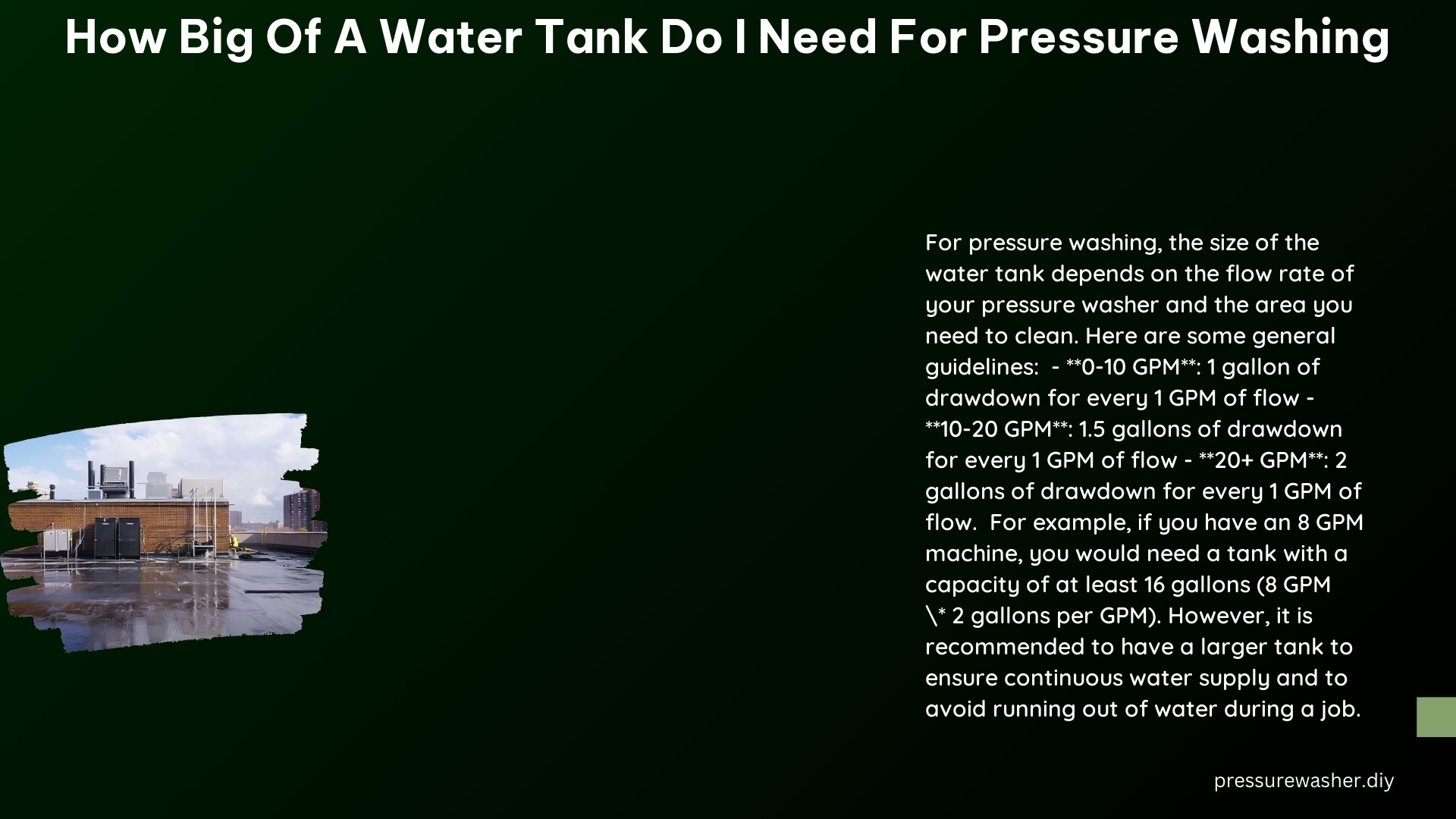When it comes to pressure washing, the size of the water tank you need is a crucial factor to consider. The right water tank size can ensure an efficient and effective pressure washing operation, while an undersized tank can lead to frequent refilling and disruptions. In this comprehensive guide, we’ll dive deep into the factors that influence the water tank size required for pressure washing, providing you with a detailed playbook to make an informed decision.
Factors Affecting Water Tank Size
1. Flow Rate of the Pressure Washer
The flow rate of your pressure washer is the primary factor in determining the size of the water tank you’ll need. The general rule of thumb is:
- For pressure washers with a flow rate of 0-10 GPM (gallons per minute), a water tank with a capacity of one gallon for every one GPM of flow is recommended.
- For flow rates between 10-20 GPM, a tank with a capacity of one and a half gallons for every one GPM of flow is recommended.
- For flow rates above 20 GPM, a tank with a capacity of two gallons for every one GPM of flow is recommended.
For example, if you have a pressure washer with a flow rate of 8 GPM, you would need a water tank with a capacity of at least 8 gallons. If your pressure washer has a flow rate of 15 GPM, you would need a tank with a capacity of at least 22.5 gallons (15 GPM x 1.5 gallons per GPM).
2. Type of Job: Residential vs. Commercial
The size of the job you’re tackling also plays a significant role in determining the water tank size.
Residential Jobs:
– Typically require smaller tanks, such as 100-200 gallons, as they often have access to on-site water supplies.
– These jobs usually involve cleaning smaller areas like driveways, patios, or siding.
Commercial Jobs:
– May require larger tanks, such as 500 gallons or more, to ensure a steady supply of water.
– Commercial jobs often involve cleaning large areas like long sidewalks, parking lots, or building exteriors.
3. Availability of On-Site Water Supplies
The availability of reliable on-site water supplies can also impact the water tank size you’ll need.
With Reliable On-Site Water Supply:
– A smaller buffer tank (e.g., 100 gallons) may be sufficient, as it can be refilled as needed.
– This setup works well when there is a consistent and accessible water source on the job site.
Without Reliable On-Site Water Supply:
– A larger water tank is necessary to carry enough water for the entire job.
– This ensures you have a sufficient water supply without relying on an on-site source.
Examples of Water Tank Sizes Used

To give you a better understanding of the water tank sizes commonly used in pressure washing, here are some examples:
| Tank Size | Typical Use |
|---|---|
| 65 gallons | Suitable for small to medium-sized jobs, can support 8 GPM pressure washers |
| 100 gallons | Commonly used for residential jobs, can support 4-5 GPM pressure washers |
| 275 gallons | Used for larger commercial jobs, can support 8 GPM pressure washers |
| 500 gallons | Used for very large commercial jobs or when there is no reliable on-site water supply |
Technical Specifications
- Water tanks are typically made of durable polyethylene material, which is lightweight, corrosion-resistant, and easy to maintain.
- The weight of a full water tank is an important consideration, as it affects the trailer or vehicle’s load capacity. A 500-gallon tank filled with water can weigh over 4,000 pounds, so it’s crucial to ensure your equipment can handle the load.
- Water tanks come in various shapes and sizes, ranging from rectangular to cylindrical, to accommodate different installation requirements and space constraints.
- Some water tanks may feature additional features like built-in baffles, which help to stabilize the water and prevent sloshing during transportation.
Conclusion
Determining the right water tank size for your pressure washing needs is essential for efficient and effective operations. By considering the flow rate of your pressure washer, the type of job, and the availability of on-site water supplies, you can select the appropriate tank size to ensure a steady and reliable water supply throughout your pressure washing projects.
Remember, investing in the right water tank size can save you time, money, and hassle in the long run, allowing you to focus on delivering high-quality pressure washing services to your clients.
References
- Pro Power Wash. (2013, January 12). Number of tanks/ Different set ups. Retrieved from http://propowerwash.com/board/upload/threads/number-of-tanks-different-set-ups.27770/
- Today’s Homeowner. (2024, April 9). How Big of a Water Tank Do I Need for Pressure Washing. Retrieved from https://todayshomeowner.com/pressure-washing/guides/how-big-of-a-water-tank-do-i-need-for-pressure-washing/
- Reddit. (2023, June 27). Water tank. Retrieved from https://www.reddit.com/r/pressurewashing/comments/14jzzje/water_tank/
- YouTube. (2020, January 16). How BIG of Water Tank Do I Need For Pressure Washing? Retrieved from https://www.youtube.com/watch?v=4-UrMpBEd8Y
- Pressure Washing Resource. (2014, April 13). What size tanks do you use? Retrieved from https://pressurewashingresource.com/community/t/what-size-tanks-do-you-use/3539
